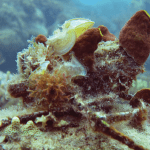A new study published in the journal Nature Microbiology highlights how emerging, devastating outbreaks of Vibrio infection in Latin America might be linked to El Niño, a climate pattern that periodically causes surface temperatures to warm throughout the equatorial Pacific Ocean. A researcher with the University of Miami’s Cooperative Institute of Marine & Atmospheric Studies at NOAA’s Atlantic Oceanographic & Meteorological Lab was part of an international research team that used microbiological, genomic, and bioinformatic tools to demonstrate how El Niño provides a mechanism for the transport of disease from Asia into the Americas.
Vibrios are rod-shaped bacteria present in the marine environment that proliferate in warm and low-salinity seawater. In the U.S. alone, Vibrio infections cause an estimated 80,000 illnesses and 100 deaths annually. There are many species of Vibrio, the best known being V. cholerae, V. vulnificus, and V. parahaemolyticus.
During the last three more significant El Niño episodes (1990-1991, 1997-1998 and 2010), new Asian variants of pathogenic Vibrio have emerged in Latin America. They include a variant of V. cholerae, which resulted in more than 13,000 deaths in Peru in 1990, and two variants of V. parahaemolyticus, which triggered widespread gastrointestinal illness associated with contaminated shellfish in 1997 and 2010.

Comparison of sea surface height anomalies during the 1997-1998 and 2015-2016 El Niño episodes in the Pacific Ocean. El Niño events impact weather patterns globally scale and may facilitate the transport of waterborne disease from the equatorial Pacific into the Americas. Image credit: NOAA
The authors observed that declared illnesses caused by waterborne bacteria reported in Latin America moved in tandem with where and when warm El Niño waters made contact with the land. Whole-genome sequencing of bacterial strains suggest there may indeed be a link between organisms that cause illness in Asia and those that emerge in Latin America, in particular, Peru and Chile.
In addition, these strains have been identified in environmental sources, providing further evidence that El Niño waters may be responsible for the transport and spread of these emergent pathogens across thousands of miles of ocean. But how can this happen?
The authors argue that Vibrio can attach to larger organisms, such as zooplankton. In numerous studies, Vibrios have been shown to bind to and use these larger organisms as an energy source. Driven by ocean currents, an El Niño event could, therefore, represent an efficient, long-distance “biological corridor,” enabling the displacement of marine organisms from distant areas. This process could provide both a periodic and unique source of new pathogens into Latin America with serious public health implications for the spread and control of disease.
The cause of sudden outbreaks of Vibrio infection in Latin America has long been a source of mystery. The authors hope their study will help coastal communities better prepare for the threat of disease outbreaks posed by El Niño episodes.
Other institutions involved in the study include the University of Bath, the US Food and Drug Administration, and the UK’s Centre for Environment, Fisheries and Aquaculture Science.
Originally Published by By Gail Derr, AOML, 2016









